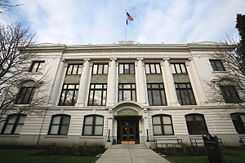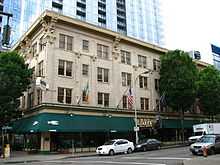William C. Knighton

William Christmas Knighton (December 25, 1864 (or 1867) – March 16, 1938) was an American architect best known for his work in Oregon. Knighton designed the Governor Hotel in Portland, Johnson Hall at the University of Oregon, and the Oregon Supreme Court Building[1] and Deepwood Estate in Salem. He served as Oregon's first State Architect from 1911–1915, appointed by Governor Oswald West. By 1915, Knighton had designed ninety building projects as State Architect. In 1919, Knighton was appointed by Governor Ben Olcott as the first President of the Oregon State Board of Architectural Examiners, a position he held until 1922. In 1920, Knighton was elected the sixth President of the Oregon Chapter of the American Institute of Architects. He remained on the Chapter's Board of the Trustees for several years and was Chair of the Chapter Legislative Committee into the 1930s.
Life
Knighton was born in Indianapolis, Indiana and later received his architectural training in Chicago and Birmingham, Alabama. He was the son of English immigrant Charles J. Knighton and Mary Hill, born in New York City.
At a very early age, "Will" Knighton learned the practical aspects of building construction and carpentry from his father's construction business and through the help of three older brothers who also worked for their father. Will's mother, Mary, died when he was nine years old. Charles Knighton relocated his construction business with the help of his four sons, to Birmingham, Alabama in the mid-1880s during the "reconstruction" era following the Civil War. Charles was accepted in business circles in part because he had remained an English citizen, rather be seen as a "northerner." Gradually the four sons took control of the business, each with their own specialities, until they pursued careers independently.
Will Knighton moved to Portland, Oregon from Birmingham in 1891 and worked for architect George W. Marshall. In 1892 Knighton moved to Salem, Oregon where he apprenticed as a draftsman with C. S. McNally until 1893.
Knighton established his own Salem office in March 1893, as a result of McNally moving to Oakland, California following the Panic of 1893. Knighton practiced alone in Salem working on state building projects and three fine Queen Ann homes. Here he became quickly recognized for his talents and established a promising career in Oregon. In 1896, with money still tight for building and a deep recession lingering, he relocated to Los Angeles where he worked for a firm in the downtown Currier Building and continued to practice. In late 1898, he returned to Salem collected his fiancée, Elinor "Lella" Waters, and, accompanied by Lella's mother, the three traveled to Indianapolis where Will and Lella were married among friends and family in October.
Following their wedding, the couple returned to Birmingham, Alabama. In 1898, Will joined his father and brothers working in allied construction fields of carpentry, masonry and architecture. For a second time, Will worked for the George Wheelock & Company until 1900, this time as Head Draftsman for the company. The Wheelock Company was one of the largest construction and building companies in Birmingham with projects throughout Alabama. In 1901, he practiced briefly as Knighton and Collington.
Following the death of his father, Knighton returned to Portland in 1902 and built his first craftsman home in Willamette Heights described as a California craftsman. He formed an office as W. C. Knighton, until 1904 when he began a partnership with William Travis, Jr., known as Knighton and Travis. He also briefly formed a partnership with J. Terry Wilding.
Knighton and Travis operated as a partnership until 1906. From 1906 until early 1910 Knighton practiced alone in Portland as W. C. Knighton, and his reputation grew. Knighton secured many large and important projects for his firm during this five year period. Knighton then entered a partnership with his lead draftsman, Edward T. Root. The partnership lasted until 1911, when in March, 1911, Knighton was appointed State Architect by Governor West, Chairman of the State Board, later the State Board of Control. Knighton relocated with Lella to Salem where he worked in offices opposite the Senate Chambers in the State Capitol Building. During his 5 year post he supervised the construction of over 90 state building projects. In 1924 he formed a partnership with Leslie Dillon Howell, which would last until Knighton's death in 1938.
Projects

- Capitol National Bank (1892 facade redesign) in Salem. Knighton was a draftsman with C. S. McNally while the redesign of the building's facade at 129 Commercial Street NE was carried out.
- Seward Hotel (a.k.a. Governor Hotel, east wing), at 611 SW 10th Avenue in Portland
- Johnson Hall at the University of Oregon in Eugene, Oregon
- Oregon Supreme Court Building in Salem
- Bayne Building at 335-349 State Street in Salem[2]
- Sarah Rosenblatt House at 2205 S.W. 21st Avenue in Portland
- Maud and Belle Ainsworth House at 2542 S.W. Hillcrest Drive in Portland
- Ashland Oregon National Guard Armory at 208 Oak St in Ashland, Oregon
- Frigidaire Building (later known as the R. J. Templeton Building)[3] at 230 East Burnside in Portland (Knighton & Howell)
- Joseph Gaston House at 1960 S.W. Sixteenth Avenue in Portland
- Judge James Watson Hamilton House at 759 S. E. Kane Street in Roseburg, Oregon
- Johnson Hall at E. 13th between University and Kincaid Sts. in Eugene
- Packard Service Building at 121 NW. Twenty-Third Avenue in Portland
- Dr. Luke A. Port House (Deepwood Estate) at 1116 Mission St. in SE Salem
- Roseburg Oregon National Guard Armory at 1034 SE. Oak Street in Roseburg
- Charles J. and Elsa Schnabel House at 2375 S.W. Park Place in Portland
- Trinity Place Apartments at 117 NW. Trinity Place in Portland (Knighton & Root)
- Whitney and Gray Building and Jake's Famous Crawfish Restaurant at 401-409 SW 12th Ave. in Portland (Knighton & Root)
References
- ↑ Finnemore, Melody. Built Like a Fortress: Preserving Oregon's Historic Supreme Court Building. Oregon State Bar Bulletin, August/September 2005. Retrieved on February 1, 2008.
- ↑ Salem Buildings
- ↑ Wendy Culverwell Templeton Building sold to investor August 13, 2004 Portland Business Journal
|